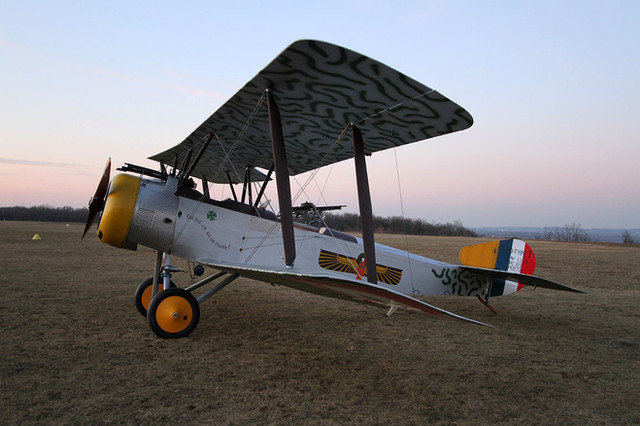

A handsome but rather frail-looking biplane powered by a 110 (later 130) hp Clerget rotary engine, the Sopwith Two-Seater or Type 9400, to give the respective R.F.C. and R.N.A.S. designations, was brought out in December 1915. It was soon given the name 1½ Strutter by reason of its oddly shaped centre-section struts.
Other unusual features of its design were the provision of air-brakes in the trailing-edges of the lower wing-roots and a tailplane which was adjustable in flight. It was the first British aeroplane to go into action with a synchronised Vickers machine gun for the pilot. The observer's gun was at first carried on a Scarff pillar mounting, then on a Nieuport ring and finally on the excellent Scarff ring. With this improved armament the Strutter did well as a two-seater fighter during the late summer and autumn of 1916. It also was used for bombing, particularly by the R.N.A.S., which developed a single-seat long-range bombing version.
Some Sopwiths then were supplied to France. Compared with the Farmans and Breguet-Michelins which formed the main body of the force, they showed up to advantage, and the French decided to build the type in quantity. Unfortunately production was very slow and when the first Sopwiths reached the front in April 1917 they were quite obsolescent. There were three versions, the SOP 1A2 (corps two-seater), the SOP 1B2 (two-seater bomber) and the SOP B1 (single-seater bomber), and various engines were installed; the 110, 130 and 135 hp Clergets, and the 80, 110 and 130 h.p. Le Rhones.
Throughout the summer and autumn of 1917 the Sopwiths equipped most of the day-bombing escadrilles; but with very feeble bomb-load and relatively weak performance. The Corps d' Armée version was more useful, but as one pilot said "the Sopwith is a good tourer, no war-plane !" The type was withdrawn from the Western Front early in 1918, and became an operational trainer.
The R.F.C. and R.N.A.S. used "only" about 1500 Strutters, whereas France built almost 4500 aircrafts for its military units. It is probably the most French of WW1 British aircrafts...
The Sop Strutter 1B2 # 2897

In May 2001, Memorial Flight began the restoration to flying condition of a 1B2 (French two-seater bombing version) Sopwith 1½ Strutter. It is one of the 4500 aircraft of this type built in France. Her background is unknown yet but the lack of metallization wire in the wings confirm a 1B2 version.
As for all Memorial Flight projects, an important restoration work was done to the highest authenticity standards, based on some original drawings we were lucky to get.
Finished as an aircraft of the Sop 66 escadrille, this aircraft is the fourth known and is the only (so far) original 1B2 flying in the world.

Sop 66 aircraft in 1917, the Egyptian eagle on aluminum doped fuselage (NOT clear doped linen !).
The restoration
Photoscopes
Photoscope
The cockpit in details.
Photoscope and video
Air brakes.
Extract from the flight manual :
"Airbrakes are used to land on exiguous fields.
Operate this device only if you are familiar with the aircraft.
The Sopwith aircraft floats a lot, therefore it is required to train on large airfields.
To land, glide down with engine in idle, and at approximatly 50 meters, increase speed by diving, then raise the airbrakes progressively by rotating the wheel drive (no need to release the brake on the wheel as it works only to prevent the airbrakes from self lowering due to the airflow)
Aircraft vibrates a little at this moment and seems to sink, increase dive and pull up when the aircraft is close to the ground, touch tail first. In these conditions, the aircraft should not roll more than 20 meters.
This landing method requires a consequent training, keep in mind that actuating airbrakes reduce aircraft glide in very large proportions."
Photoscope
Front cockpit under construction.
Photoscope
Rear cockpit under construction.
Photoscope
Gunner seat.
Photoscope
The TO-3 ring (based on the Scarff ring).
Photoscope
Main fuel tank.
Note : The tank is made of tinned steel assembled with copper rivets. It is a non pressurized tank (French system) with a capacity of 170 liters.
Different wings ?
Fuel Tanks.
During the study we undertook prior to the restoration process, we found differences between the wings in our possession, built by REP in 1917, and the original Sopwith drawings. The French maintenance manuals confirms that fact. The modifications deal mainly with a simplified and bigger diameter internal stringer system and a reinforced rib for the upper wings.
Pieces of history
Original matricule booklet
Original matricule booklet of a French sop strutter build by "SAIB" (Société Anonyme d'Applications Industrielles du Bois), for aicraft serial #7054 delivered on July 23rd 1918. 280 Strutters were built by SAIB.
Manufacturing date
A stamp, found on the top right wing main front spar, tells us that this wing was checked on May 23rd 1917 (23 MAI 1917) so we can imagine that the aircraft was built in May-June 1917.

Control stamps
Some stamps were found on the top right wing main front spar.

Photo Album
Videos
Sopwith 1B2 Strutter, June 2010 : First engine run of the Sopwith Strutter. (3min23s)
Sopwith 1B2 Strutter, April 2012 : Very first take-off of the Sopwith Strutter. (51s)
Sopwith 1B2 Strutter, April 2012 : First flight of the Sopwith Strutter. (2min36s)
Sopwith 1B2 Strutter, May 2012 : GoPro footage included / Training flight - La Ferté-Alais 2012 airshow. (3min28s)
Specifications
Length: 7.69 m
Wingspan: 10.21 m
Weight: 975 kg
Engine: 1x 130 hp Clerget engine
Speed: 161 km/h
Endurance: 3 h 45
Crew: 2
Armament: 1x .303 (7.65mm) Vickers machine gun on the left side of the fuselage + 1x .303 (7.65mm) Lewis machine gun, on TO3 turret























